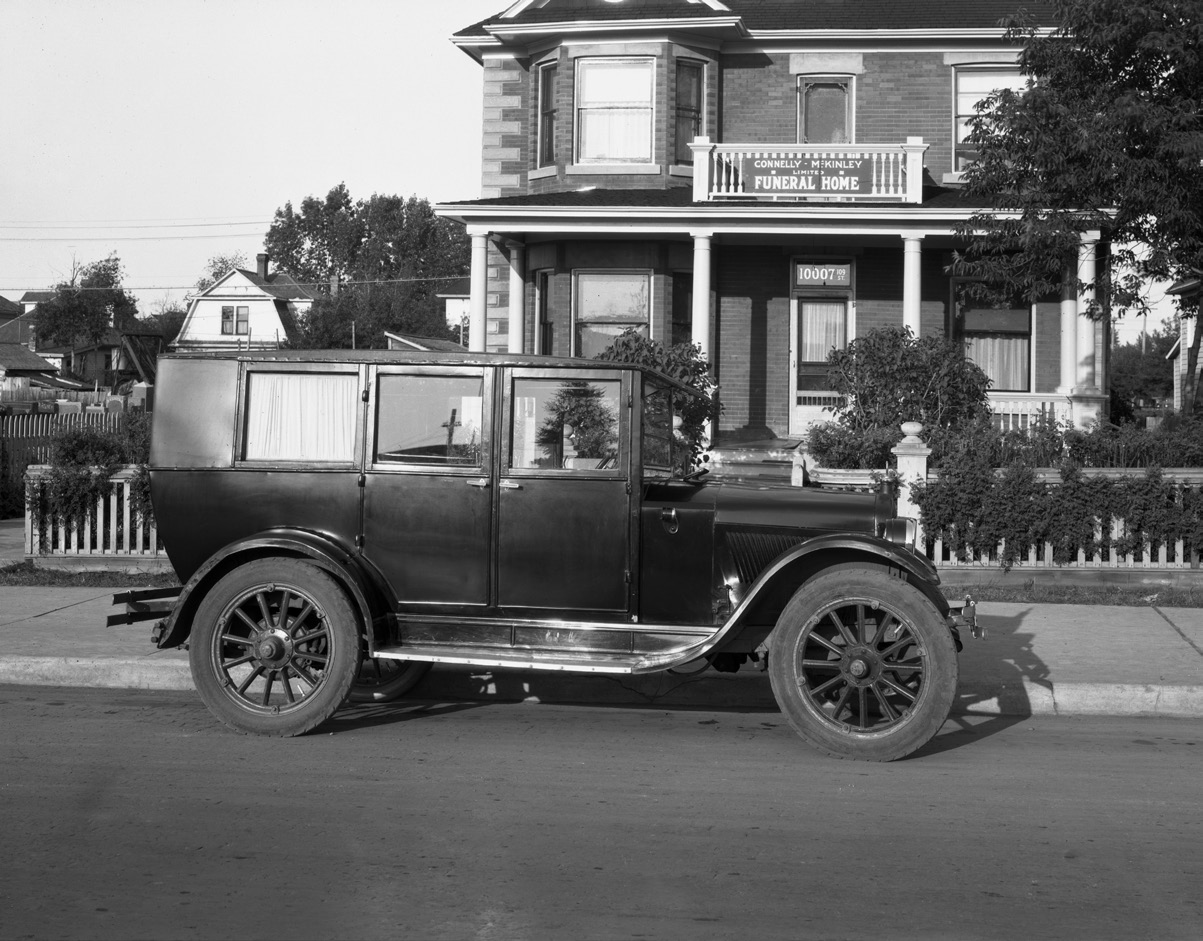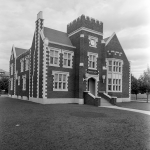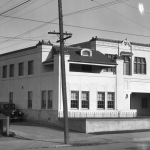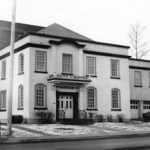Funeral homes and crematoriums can be found scattered around Edmonton today, but through most of the 20th century, downtown was “the dead centre of town” in more ways than one. The city’s earliest funeral businesses were called undertakers, and they were typically family-run ventures. Many stayed in their families for two or more generations, and they buried and cremated successive generations of families.
Here’s a look at four of Edmonton’s beloved landmark funeral parlours, all dearly departed.
1) Connelly-McKinley Ltd., 10007 109 Street
Joseph William Connelly and James H. McKinley established Connelly-McKinley Funeral Home & Crematorium Ltd. on February 26, 1908, the first incorporated funeral company in Alberta. It was first situated at 212 McDougall Avenue (now 100th Street), just across from the old main post office.
McKinley owned the Windsor Livery Stable and supplied the horses to pull hearses and ambulances, and so the partnership was a natural one. The stable’s phone number was 2222, and it was passed on to Connelly-McKinley. More than 100 years later, the number is still in use by the company as 422-2222.
In 1910 the funeral home relocated around the corner to 136 Rice Street (now 101A Avenue) and then, three years later, moved again to the corner of Howard Avenue (100A Street) and Elizabeth Avenue.
Connelly and McKinley were innovators, and their firm was the first funeral home west of the Great Lakes to use an automobile for its hearse and ambulance.
The business was also one of the first in Canada to use pressure embalming, and Connelly’s wife Isabelle became the first female embalmer in the province of Alberta. They raised their children to be active in the business, too, and son William James began driving the firm’s ambulance at age 12, with special permission from the police. Three of William’s children were later to become partners in the firm.
In June 1926 Connelly bought and remodelled a residence on 109th Street just north of 100th Avenue. The main floor was converted for use as a funeral parlour while the upper floor served as his family’s residence.
During the 1930s the Connelly family bought out the shares owned by James McKinley, and in 1941 the premises were entirely rebuilt and then enlarged and remodelled in 1954. The location served the company until 1981, when the modern Floral Chapels opened at 10011 114th Street, and the long-serving location was torn down.
2) Andrews Brothers’ Funeral Home, 11206 Jasper Avenue
Alexander Andrews and his two sons William and Robert opened the Andrews Brothers’ funeral home in June 1908 on First Street just south of Jasper Avenue. It would later become Andrews and Sons, Undertakers and Embalmers, at what is now 10556 97th Street.
The business prospered, and the family purchased a building site on the northwest corner of Jasper Avenue and 112th Street. It was the depths of the Great Depression but they were able to build anyway, and in 1932 opened a richly detailed funeral chapel faced with bricks and masonry.
As was typical for many funeral homes of the era, it had living quarters on the second floor. A clock situated right above the main entrance left locals to quip: “Your time is coming!”
George McLaughlin and his son Don, hardware store operators in Wetaskiwin and Tofield and undertakers in Tofield, assumed ownership in July 1940. The name of the firm was changed to Andrews-McLaughlin Funeral Chapel Ltd.
Don died in a gliding accident at Cooking Lake in October 1964 and George sold the business to two former employees, Max Baron and Robert Long. In March 1981 the funeral home site at 11206 Jasper Avenue was sold and the firm moved into a new chapel at 10011 114 Street. The 1932 building was then demolished, replaced by a strip mall.
3) Howard & McBride Funeral Home, 10045 109 Street
R.F. Howard and Thomas Wilfred “Mac” McBride went into funeral service together in 1921, and began operating from a building at 10535 Jasper Avenue. In 1927 they purchased a vacant lot on the east side of 109th Street, just south of Jasper Avenue, and set about building a new funeral parlour.
They commissioned renowned Edmonton architects George Heath MacDonald and Herbert Magoon to design one of the finest funeral facilities in Western Canada. Inspired by Spanish architecture, the new building was clad with stone, roofed with clay tiles and appointed with the finest interior finishings. When it opened in July 1929, it boasted an air-conditioned 135-seat chapel with Edmonton’s first Casavant pipe organ and four slumber rooms “where relatives may view their departed ones.”
Over the next 59 years, the Howard & McBride Funeral Home was a place of goodbyes for thousands of Edmontonians. The final farewells came in 1988, when the business was sold to become part of Roy and Owen’s Chapel of Chimes.
Between 1988 and 2009, the former funeral home functioned as various restaurants and nightclubs. It was demolished in November 2009.
Mac McBride was active into his twilight years, and still drove in occasional funeral processions until he was 90. McBride died in 1980 at the ripe old age of 92.
4) Foster & McGarvey Ltd., 10008 103 Street
Harold P. Foster was just 18 years old in 1918 when he began working at the McCoppen Funeral Home at 9944 101A Avenue. He bought the business and renamed it Foster’s Funeral Home. In 1928 he completed a deal to relocate to 10008 103 Street, but then died suddenly on May 11, 1929. He was only 28 years old.
Harold’s wife Jean hired Donald McGarvey to run the firm, and it was reconstituted as Foster & McGarvey. The 103rd Street residence, the former home of Dr. Braithwaite, the provincial coroner, was renovated to serve as a funeral chapel and crematorium.
Jean sold out to Donald and moved to Ottawa. After Donald died, son Donald Jr. took over in 1982. The firm joined forces with Connelly-McKinley in February 2006, and moved to 10011 114 Street. The funeral home on 103rd Street was demolished in May 2006.





